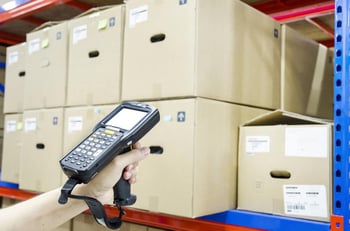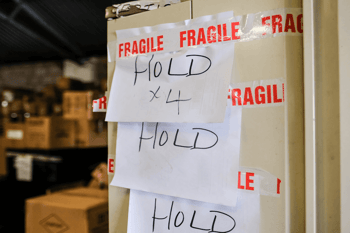
Now that the COVID-19 pandemic has given online shopping an unprecedented boost, how products get to consumers and delivery time have taken on increasing importance. Unfortunately, logistics providers have suffered from their own setbacks thanks to supply chain, labor, and other challenges over the past several years.
But, this is a highly competitive industry, so online retailers must address fulfillment issues to remain competitive. Fortunately, there are plenty of solutions available.
Here is what you need to know about getting these orders into the right hands and some tips for optimizing your eCommerce fulfillment strategy to make your operations even stronger going forward.
What Does eCommerce Fulfillment Involve?
eCommerce order fulfillment is the entire process of delivering online orders to customers. It involves inventory management, order processing, picking and packing orders, and shipping items to customers. Just getting products out the door of the warehouse isn’t enough. A well-optimized eCommerce order fulfillment process can make or break your business.
Why Your eCommerce Fulfillment Strategy Matters
As more consumers turn to online sources for their products, businesses are seeing the benefit of leveraging eCommerce as a profitable business strategy. But many customers will choose an online retailer based on how it plans to fulfill the order just as much as the items themselves. The quality of your fulfillment strategy matters for several reasons:

1. More Sales
When you offer a pleasant order fulfillment experience, you are going to get more sales than your competitors. For example, consumers will choose the seller that offers faster delivery, has a record of less product damage, or gives customers tracking information for orders.
2. Reduced Costs
Order fulfillment costs can be substantial. But it actually costs more when you are inefficient. By optimizing your processes, you can do more with less staff, manage your limited warehouse space better, and process orders quicker. All of this translates into lower costs and higher profits.
3. Improved Reputation
Today’s consumers judge brands by their online reputation. If you can build a positive reputation for getting orders to customers quickly, accurately, and without any damage, you will meet or exceed expectations.
5 Strategies for Optimizing eCommerce Fulfillment
The eCommerce order fulfillment process begins before a customer ever places an online order. Businesses must have the inventory and process in place to ensure that customers will get what they’ve ordered quickly and correctly. Here are the different elements of the process and how you can optimize them.
1. Inventory Management
 eCommerce businesses must have goods on hand to be able to fulfill orders from consumers. They can get them directly from manufacturers or some other supplier. But the trick is knowing the level of goods to have on hand to keep up with product demand and deal with seasonality. You will face stock-outs and lose customers if you have too little on hand. But having too much inventory on hand is costly and inefficient.
eCommerce businesses must have goods on hand to be able to fulfill orders from consumers. They can get them directly from manufacturers or some other supplier. But the trick is knowing the level of goods to have on hand to keep up with product demand and deal with seasonality. You will face stock-outs and lose customers if you have too little on hand. But having too much inventory on hand is costly and inefficient.
How to Optimize:
To optimize your eCommerce inventory management process, you’ll want to take advantage of technology solutions and forecasting. Specifically, a warehouse management system (WMS) can help you keep track of what you have and give you the data you need to make more informed decisions about what you should keep on hand. This type of system also allows you to set automated re-order triggers so that you can avoid stock-out situations.
2. Order Management
 The next element in eCommerce order fulfillment is managing the orders that come in from customers. When a customer hits “Submit” on the Shopping Cart checkout page, what happens next? In their mind, your warehouse should already be processing their order. If there is a delay, it could impact the customer experience.
The next element in eCommerce order fulfillment is managing the orders that come in from customers. When a customer hits “Submit” on the Shopping Cart checkout page, what happens next? In their mind, your warehouse should already be processing their order. If there is a delay, it could impact the customer experience.
How to Optimize:
One of the best ways to make this process more efficient is to integrate your entire eCommerce order fulfillment process through your WMS. Customers get a real-time view of inventory availability, and your warehouse will get immediate notification of new orders so that processing can begin.
3. Picking and Packing
 As soon as your warehouse receives notification of a new order, those items should start moving in the right direction - towards the customer. The first two steps in this process are picking, where the item is removed from inventory, and packing, where it is packaged for shipping. If not managed properly, these processes can be incredibly inefficient.
As soon as your warehouse receives notification of a new order, those items should start moving in the right direction - towards the customer. The first two steps in this process are picking, where the item is removed from inventory, and packing, where it is packaged for shipping. If not managed properly, these processes can be incredibly inefficient.
How to Optimize:
Using your WMS in connection with other solutions like RFID codes and mobile warehouse technology can significantly improve the efficiency and accuracy of picking and packing activities. RFID gives your organization instant access to inventory and order information. Workers can also use mobile solutions like wearables and mobile carts to improve the speed, accuracy, and efficiency of these tasks.
4. Shipping
Once a customer’s order has been pulled from the shelf and packed, it needs to be shipped. If your business doesn’t have reliable processes or shipping partners, orders can become bottlenecked at this point in the process.
How to Optimize:
Many eCommerce retailers are now giving customers options to improve their experience. These include curbside pickup, BOPIS (buy online pick up in store), same-day delivery, and traditional delivery. It’s important to keep your customers informed about their options as well as to have complete visibility throughout your supply chain when you offer this many choices. It’s also a good idea to partner with multiple shipping providers and consider using local order fulfillment centers to reduce the distance between the warehouse and the final destination.
5. Returns
 Getting your products into the customer’s hands may not be the end of the order fulfillment process. In some cases, those same products take a reverse trip back to your warehouse in the form of returns or recalls. How you handle reverse logistics can also make a difference in the customer experience and your overall results.
Getting your products into the customer’s hands may not be the end of the order fulfillment process. In some cases, those same products take a reverse trip back to your warehouse in the form of returns or recalls. How you handle reverse logistics can also make a difference in the customer experience and your overall results.
How to Optimize:
The best approach to reverse logistics is to not make the process an afterthought. Incorporate it into your overall operation by creating processes to handle returns and add value by reselling or recycling items that come back through your doors. Your technology solutions will be just as helpful in keeping track of these items coming in the reverse direction.
The global eCommerce industry is expected to hit $5 trillion this year alone, which is a massive figure. If you’re an online business or participate in this industry, it’s also a significant opportunity. Implementing some of these ideas to optimize your eCommerce fulfillment strategy will help your business improve its overall results.

